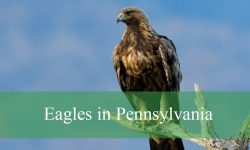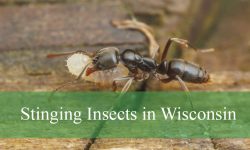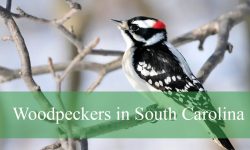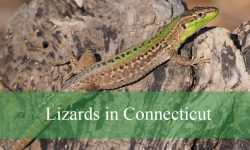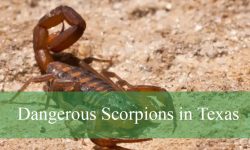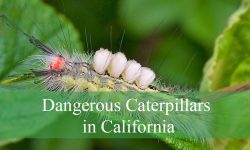In New York, a remarkable diversity of bird species can be found, from vibrant songbirds in city parks to majestic waterfowl along its rivers and wetlands. Birdwatchers and nature enthusiasts alike can enjoy spotting these birds throughout the year, in both urban neighborhoods and natural reserves.
This guide highlights 45 common birds in New York, providing detailed descriptions, identification tips, and photographs to help both beginners and experienced birdwatchers recognize them. Each entry covers size, behavior, habitat, and distinctive features, making bird identification easier and more enjoyable.
Exploring the Adirondacks, wandering Central Park, or observing backyard feeders, you can discover the birds most commonly seen in New York. This comprehensive list offers insight into local wildlife and is perfect for anyone looking to deepen their connection with nature.
Most Common Birds Found in New York
American Robin (Turdus migratorius)
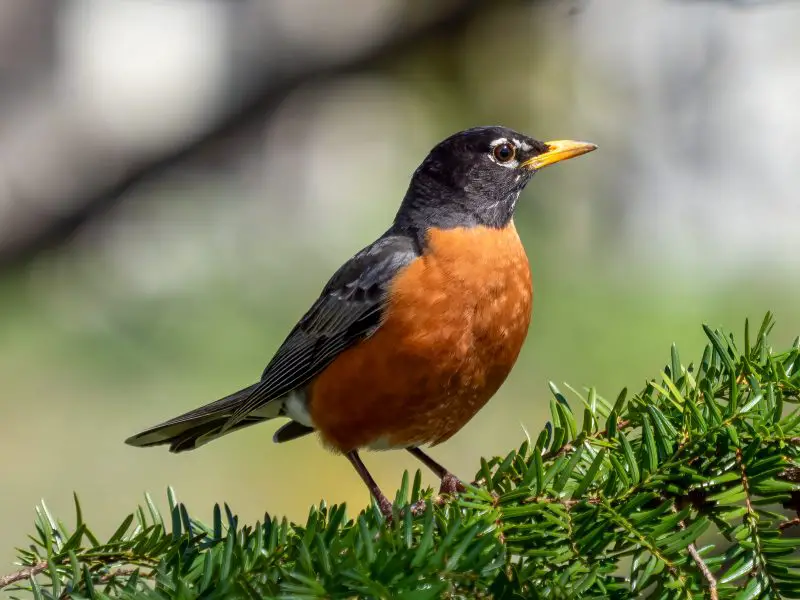
The American Robin is one of the most recognizable birds in New York, known for its bright orange breast and cheerful song that often signals the arrival of spring. Adults have a grayish-brown back, a yellow bill, and a white underbelly that contrasts beautifully with their rusty-red chest. They measure about 9 to 11 inches in length with a wingspan of 12 to 16 inches, making them medium-sized songbirds easily spotted in backyards, parks, and woodlands.
These robins are highly adaptable and can be found across urban, suburban, and rural landscapes. In New York, they thrive in gardens, open fields, and forest edges where they forage for earthworms, insects, and fruit. They are often seen hopping across lawns, tugging worms out of the soil, especially after rain. During winter, they gather in flocks, sometimes numbering in the hundreds, as they search for berries and other food sources.
A fun fact about the American Robin is that while many associate them with spring, not all robins migrate south. Some remain in New York throughout the winter, though they become less noticeable as they spend more time in wooded areas. Their iconic song, a series of clear whistles, is among the most familiar bird calls in the region and is often heard at dawn and dusk.
Northern Cardinal (Cardinalis cardinalis)
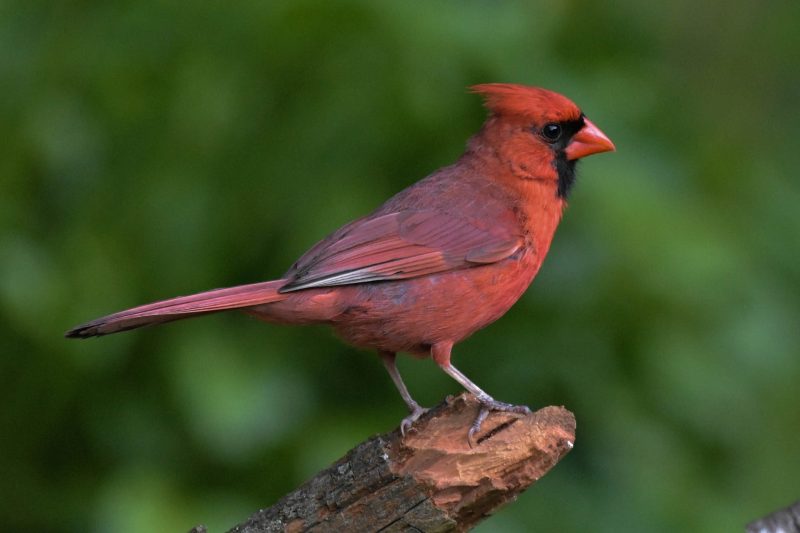
The Northern Cardinal stands out in New York with its brilliant plumage and striking appearance. Males are bright red with a black mask around the face, while females are a warm brown with reddish highlights on their wings and crest. Both sexes have a prominent crest and a stout, cone-shaped orange bill. They measure about 8 to 9 inches in length, with a wingspan of 10 to 12 inches, making them a medium-sized but unmistakable bird.
These birds are year-round residents of New York and prefer habitats like backyards, woodland edges, and shrubby areas. They are frequent visitors to bird feeders, especially those offering sunflower seeds. Cardinals are also known for their loud, clear whistles, which both males and females sing. Their songs help them defend territories and communicate with mates, making them quite vocal compared to many other species.
A fun fact about Northern Cardinals is that they are one of the few songbird species in which females sing as well as males. In some cases, the female’s song can even provide cues to the male about when to bring food to the nest. Their striking colors and year-round presence make them a favorite among birdwatchers and a symbol of beauty during New York’s snowy winters.
Blue Jay (Cyanocitta cristata)
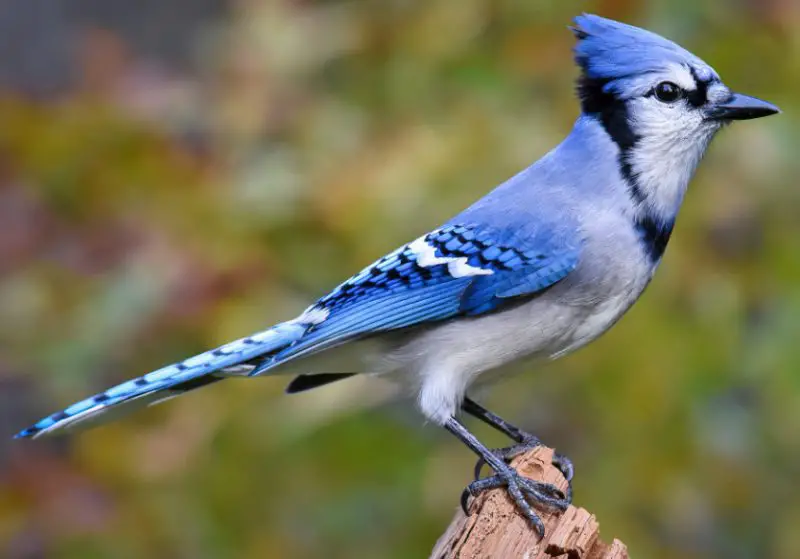
The Blue Jay is a bold and intelligent bird, easily recognized by its vivid blue plumage, black necklace-like markings, and white underparts. They measure around 9 to 12 inches long with a wingspan of 13 to 17 inches. Their loud calls, often described as harsh “jay-jay” sounds, make them hard to miss in New York’s parks and neighborhoods. The crest on their head can be raised or lowered, signaling their mood or alertness.
Blue Jays are commonly found in forests, suburban areas, and backyards, where they often visit bird feeders. They are omnivorous, feeding on acorns, seeds, insects, and occasionally small vertebrates. Known for their intelligence, Blue Jays sometimes mimic the calls of hawks to scare away other birds. They also play an important ecological role by spreading oak trees—burying acorns for later consumption but forgetting some, allowing them to germinate.
A fun fact about Blue Jays in New York is that their striking blue feathers are not actually pigmented blue. Instead, the color results from the microscopic structure of their feathers scattering light, a phenomenon called structural coloration. This means that if you crushed a Blue Jay feather, the blue color would disappear. Their combination of beauty and cleverness makes them one of the most fascinating backyard birds in the state.
Black-capped Chickadee (Poecile atricapillus)
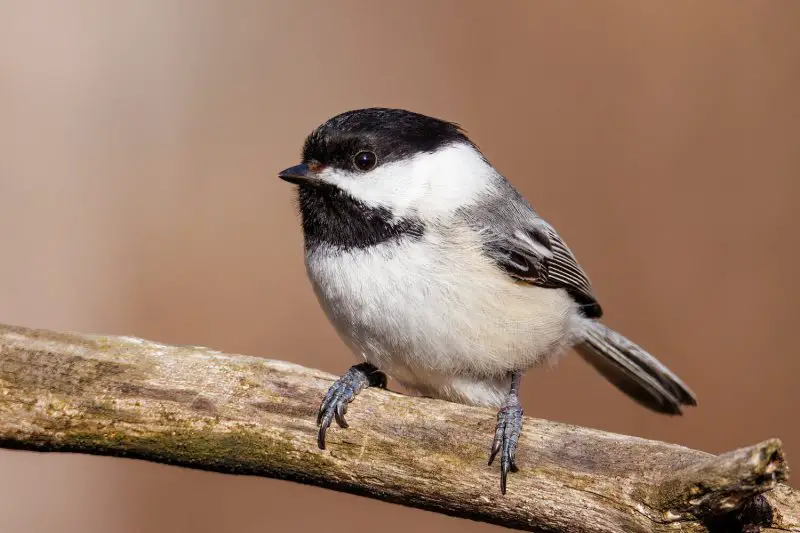
The Black-capped Chickadee is a small, charming bird known for its curiosity and friendliness around humans. It has a distinctive black cap and bib, white cheeks, a soft gray back, and buffy sides. Measuring only about 4.5 to 5.5 inches in length with a wingspan of 6 to 8 inches, it is one of the smallest yet most energetic birds commonly seen in New York.
Chickadees are highly adaptable and live in woodlands, suburban gardens, and parks across the state. They are year-round residents that feed on insects, spiders, seeds, and berries. At feeders, they often grab a single seed, fly to a nearby perch, and peck it open before returning for another. They are also known for storing food in hidden spots, remembering thousands of locations to help them survive harsh winters.
A fun fact about the Black-capped Chickadee is that it can lower its body temperature during freezing nights, entering a controlled hypothermic state to conserve energy. Their distinctive “chick-a-dee-dee” call is not only a namesake but also a complex communication system—the number of “dee” notes can indicate the level of threat from predators. Their lively behavior and tameness often delight New Yorkers during winter birdwatching.
Mourning Dove (Zenaida macroura)
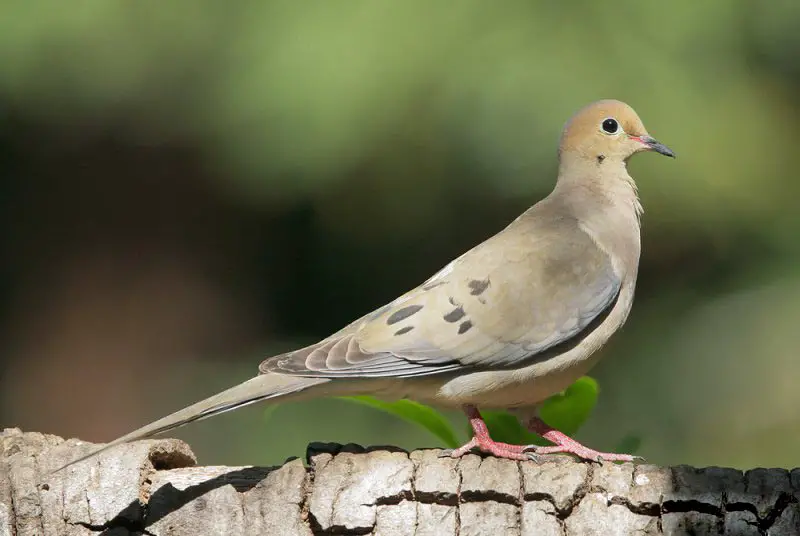
The Mourning Dove is a graceful and slender bird, recognized by its soft grayish-brown body, long pointed tail, and black spots on its wings. Adults measure 9 to 13 inches in length with a wingspan of 17 to 18 inches. Their gentle cooing calls, often mistaken for an owl by beginners, give them their name and add a peaceful sound to New York’s mornings and evenings.
These doves are common across the state in open fields, farmlands, and suburban backyards. They are ground feeders, primarily eating seeds, which they swallow quickly and store in their crop to digest later in a safe perch. Mourning Doves are strong fliers, capable of reaching speeds up to 55 miles per hour, and their wings produce a distinct whistling sound when they take off.
A fun fact about Mourning Doves is that they are among the most hunted game birds in North America, yet their populations remain stable due to their prolific breeding. A pair can raise up to six broods per year in New York, each with two eggs. Their adaptability, peaceful appearance, and soft calls make them a familiar and beloved part of the state’s birdlife.
American Crow (Corvus brachyrhynchos)
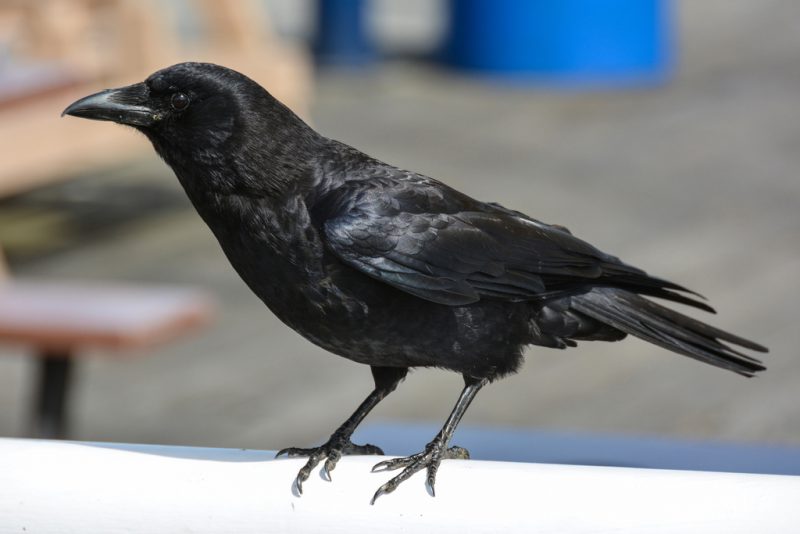
The American Crow is one of the most intelligent and adaptable birds in New York. Large and glossy black, these birds measure 16 to 21 inches long with a wingspan of 33 to 39 inches. Their cawing calls are loud and distinctive, often heard echoing through both rural and urban landscapes. They are highly social birds, often gathering in large flocks, especially during winter roosts that can number in the thousands.
Crows thrive in nearly every habitat across New York, from forests and farmlands to city streets and garbage dumps. They are opportunistic feeders, eating everything from insects and seeds to carrion and human scraps. Their intelligence is well documented—they use tools, recognize individual human faces, and even teach behaviors to younger generations. This adaptability allows them to live successfully alongside people in busy environments.
A fun fact about American Crows in New York is that they are known to hold “funerals.” When one crow dies, others gather around, caw loudly, and appear to study the situation. Scientists believe this behavior helps them learn about potential dangers in the area. Their problem-solving skills and fascinating social lives make them one of the most remarkable and studied birds in the state.
European Starling (Sturnus vulgaris)
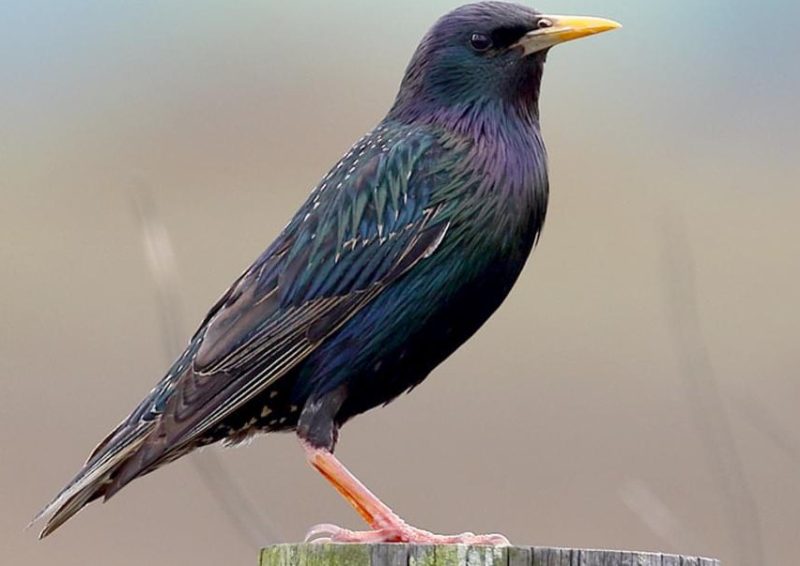
The European Starling is a medium-sized bird easily recognized by its glossy black plumage that shimmers with purple and green iridescence in the sunlight. During the winter, their feathers are speckled with white spots, giving them a distinctive look. Measuring about 8 to 9 inches in length with a wingspan of 12 to 16 inches, they have pointed wings and a short tail, making their flight fast and direct. Their long, yellow bill is especially noticeable during the breeding season.
In New York, European Starlings are common year-round residents, thriving in both urban and rural areas. They often gather in massive flocks, sometimes numbering in the thousands, especially during fall and winter. These flocks, called murmurations, move in incredible synchronized patterns across the sky, creating one of the most breathtaking spectacles in nature. Starlings feed on insects, fruits, and grains, often foraging on lawns and agricultural fields.
A fun fact about European Starlings is that they were introduced to North America in the late 1800s by a group that wanted to bring every bird mentioned in Shakespeare’s works to the continent. From just 100 birds released in Central Park, the population has exploded to millions across the country, making them one of the most successful and widespread invasive bird species.
House Sparrow (Passer domesticus)
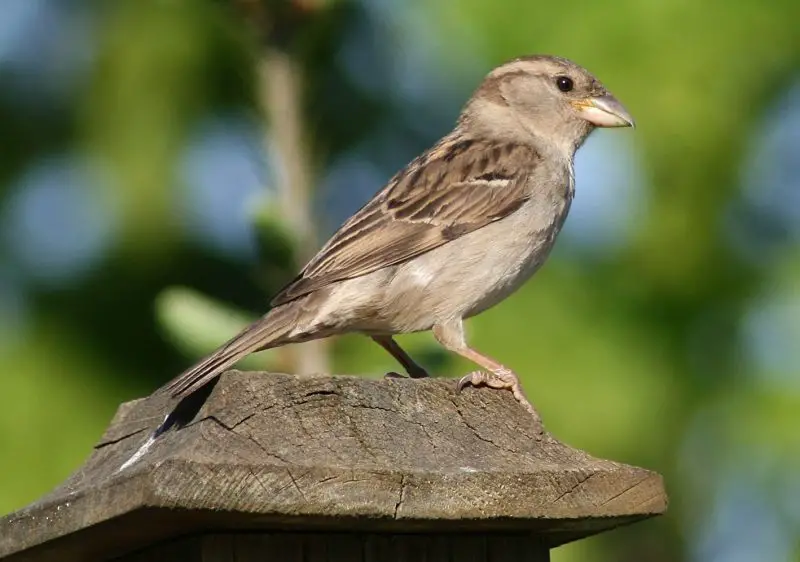
The House Sparrow is a small, chunky bird with a short tail and strong bill, measuring about 5.5 to 6.5 inches in length with an 8 to 10-inch wingspan. Males are easily identified by their gray crown, black bib, and chestnut-colored nape, while females are more subtly patterned in brown and gray tones. Their compact size and lively chirping calls make them familiar residents of neighborhoods throughout New York.
House Sparrows are highly adaptable and thrive in areas where people live, often nesting in crevices of buildings, streetlights, and eaves. They feed on a wide variety of foods, including seeds, crumbs, and even insects, making them a common visitor to outdoor cafés, backyards, and city streets. These birds are extremely social, often found in noisy flocks hopping along sidewalks or clustered around feeders.
A fun fact about House Sparrows is that they are not native to North America but were introduced from Europe in the mid-1800s. Today, they are one of the most widely distributed bird species in the world, living almost everywhere people do. Their close association with humans has earned them the nickname “feathered neighbors,” and in New York City, they are as much a part of daily life as pigeons and squirrels.
Song Sparrow (Melospiza melodia)
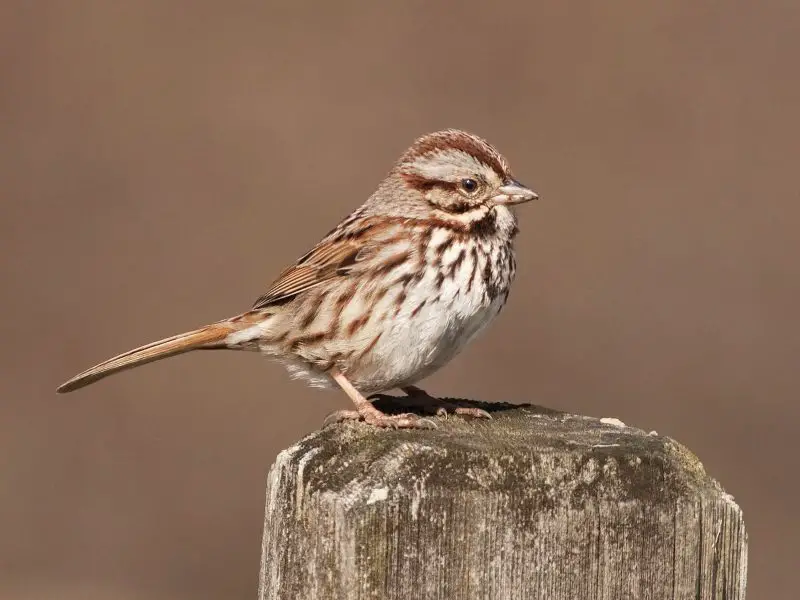
The Song Sparrow is a medium-sized, streaked brown bird with a long tail and a distinctive dark central breast spot. Measuring about 5 to 7 inches long with a wingspan of 7 to 9 inches, they are common but variable in appearance, often blending into brushy or grassy habitats. Their melodic and complex song, often described as cheerful and varied, is one of the most recognizable sounds in New York’s natural landscapes.
Song Sparrows are found across New York in a wide range of habitats, from marshes and meadows to forest edges and suburban gardens. They spend much of their time close to the ground, foraging for seeds and insects. Their adaptability allows them to live both in rural farmlands and within city parks, making them one of the most widespread sparrows in the state.
A fun fact about Song Sparrows is that males can sing up to 20 different song variations, often customizing their tunes to match or compete with neighboring males. This makes them fascinating to listen to, as their songs are not only for attracting mates but also for defending territories. Their cheerful presence and lively songs add a musical quality to New York’s landscapes year-round.
White-throated Sparrow (Zonotrichia albicollis)
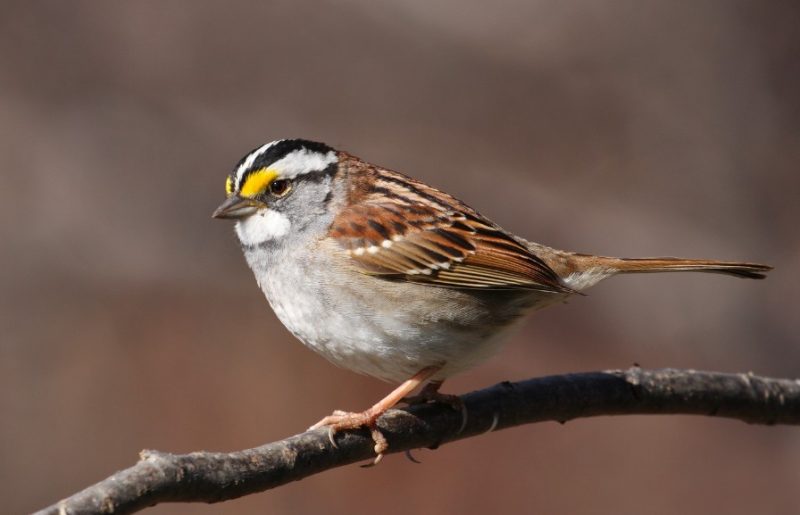
The White-throated Sparrow is a striking bird recognized by its bold head pattern, featuring black-and-white stripes on the crown and a bright yellow spot between the eyes and bill. Its white throat patch contrasts with its gray breast, making it easy to identify. These sparrows measure about 6.5 to 7.5 inches in length with a wingspan of 9 inches, making them slightly larger than most sparrows seen in New York.
They are especially common during migration and winter, when flocks gather in parks, gardens, and woodlands across the state. White-throated Sparrows forage mostly on the ground, scratching through leaves in search of seeds, berries, and insects. Their sweet, whistled song, often described as sounding like “Old Sam Peabody, Peabody, Peabody,” is a familiar sound in New York during spring and fall migrations.
A fun fact about the White-throated Sparrow is that it comes in two distinct color morphs: white-striped and tan-striped. These morphs pair up in an unusual way—white-striped birds almost always mate with tan-striped birds, maintaining balance in the population. This unique pairing system makes them one of the most studied sparrow species in North America.
House Finch (Haemorhous mexicanus)

The House Finch is a small, lively bird measuring 5 to 6 inches long with an 8 to 10-inch wingspan. Males are easily identified by their rosy-red foreheads, throats, and chests, which contrast with streaked brown bodies. Females lack the red coloration, appearing streaky brown and gray overall. Their cheerful, warbling songs are a common sound in New York’s neighborhoods, especially near bird feeders.
Originally native to the western United States, House Finches were introduced to the East Coast in the 1940s and quickly spread across New York and beyond. They thrive in urban, suburban, and rural areas, often nesting on buildings, trees, or even hanging baskets. Their diet mainly consists of seeds, fruits, and buds, and they are frequent visitors to backyard feeders.
A fun fact about House Finches is that the intensity of the male’s red coloration comes from pigments in their diet. Brighter males are often more attractive to females, as the red signals good health and strong foraging abilities. This makes them a great example of how diet can directly influence bird appearance and mating success.
American Goldfinch (Spinus tristis)
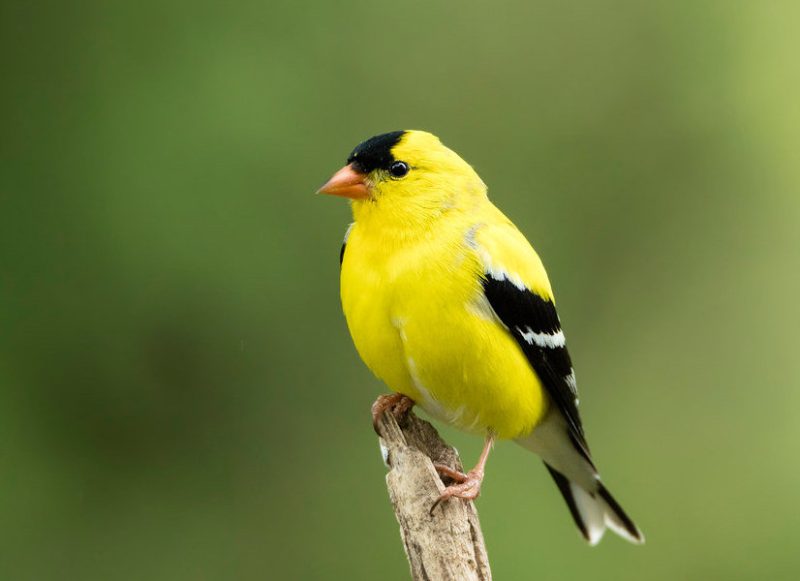
The American Goldfinch is a small, vibrant bird that brings a splash of color to New York’s landscapes. During the breeding season, males are bright yellow with a black cap and black wings, while females are a duller yellowish-brown. In winter, both sexes molt into a more muted olive-brown plumage. Measuring 4.5 to 5 inches long with a wingspan of 7 to 9 inches, they are among the smallest finches in the region.
Goldfinches are commonly found in fields, gardens, meadows, and backyards throughout New York. They are strict seed eaters, with a preference for thistle, sunflower, and dandelion seeds. Their undulating flight pattern, where they alternate between flapping and gliding, is distinctive and often accompanied by cheerful calls. They also visit feeders, particularly those stocked with nyjer seed.
A fun fact about American Goldfinches is that they are one of the latest-breeding songbirds in North America, waiting until midsummer to raise their young when thistle and other seed plants are abundant. Their cheerful songs, acrobatic feeding style, and bright colors make them a favorite among bird enthusiasts across the state.
Red-winged Blackbird (Agelaius phoeniceus)
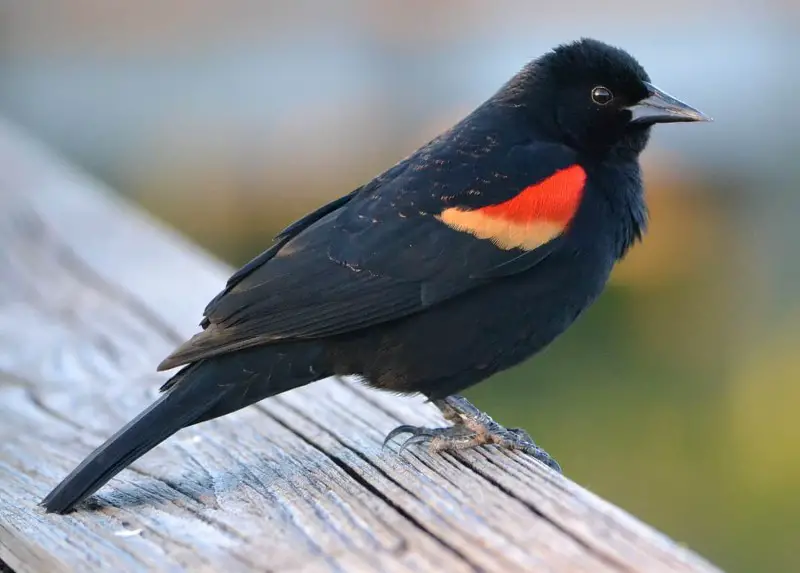
The Red-winged Blackbird is a striking bird, best known for the male’s glossy black plumage and bright red shoulder patches bordered with yellow. Females, in contrast, look very different, resembling large, streaky brown sparrows with subtle hints of reddish tones. Measuring about 7 to 9 inches in length with a wingspan of 12 to 16 inches, they are medium-sized birds that are easy to identify when perched on reeds or fence posts.
In New York, Red-winged Blackbirds are most commonly seen in wetlands, marshes, and grassy fields, though they also frequent roadsides and suburban edges. Males are highly territorial during the breeding season, often perching prominently and singing their distinctive “conk-la-ree” call to announce ownership of an area. Outside the breeding season, they form large flocks, sometimes mixed with other blackbirds and starlings, as they forage for seeds and insects.
A fun fact about the Red-winged Blackbird is that males can defend territories of up to half an acre and may mate with multiple females within that space. Their bold behavior, vivid markings, and loud songs make them one of the most noticeable and studied birds in New York’s wetlands.
Common Grackle (Quiscalus quiscula)

The Common Grackle is a tall, long-tailed blackbird with iridescent feathers that shimmer in purple, blue, and green hues depending on the light. Its pale yellow eyes stand out against its dark head, giving it a piercing expression. Measuring about 11 to 13 inches long with a wingspan of 14 to 18 inches, grackles are larger and more slender than most blackbirds in New York.
These birds are highly adaptable and thrive in a wide range of habitats, from farmlands and fields to suburban lawns and city streets. They often forage in noisy flocks, feeding on grains, insects, small animals, and even food scraps from urban environments. Known for their strong, purposeful stride, grackles are often seen strutting across lawns or perching in groups on power lines.
A fun fact about Common Grackles is that they have been observed dunking food in water before eating it, possibly to soften it or make it easier to swallow. Their intelligence, combined with their glossy appearance, makes them one of the more fascinating yet sometimes misunderstood birds of New York.
Gray Catbird (Dumetella carolinensis)
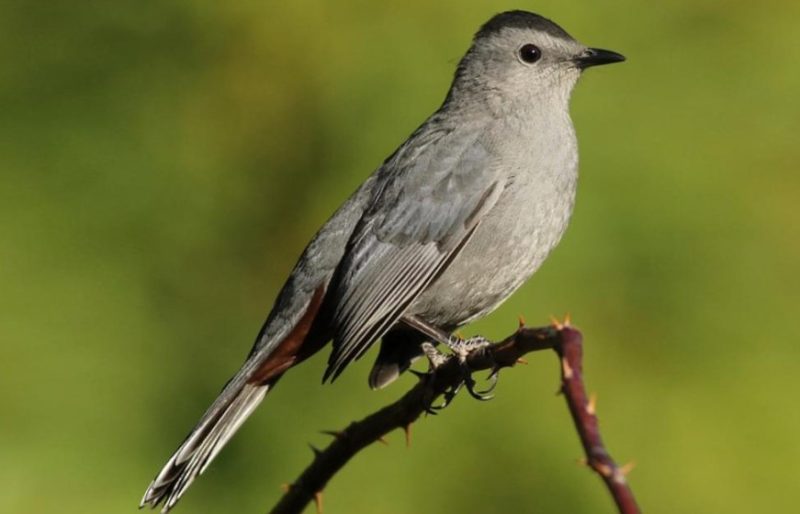
The Gray Catbird is a slender, medium-sized songbird with soft slate-gray plumage, a darker cap, and a rusty patch beneath the tail. Measuring about 8 to 9 inches in length with an 11-inch wingspan, it has a graceful appearance that blends well into dense thickets. Its name comes from its distinctive cat-like “mew” call, which makes it easy to identify even when hidden in foliage.
In New York, Gray Catbirds are commonly found in shrubby habitats, forest edges, gardens, and backyards with dense vegetation. They are skilled mimics, capable of copying the songs of other birds, frogs, and even mechanical sounds. Unlike the Northern Mockingbird, which repeats phrases, catbirds usually string together a continuous stream of varied notes and calls, creating a unique and sometimes quirky song.
A fun fact about the Gray Catbird is that it belongs to the same family as mockingbirds and thrashers, all known for their vocal talents. Catbirds often return to the same breeding territory year after year, especially if food and cover are plentiful, making them reliable seasonal visitors in New York gardens.
Northern Mockingbird (Mimus polyglottos)
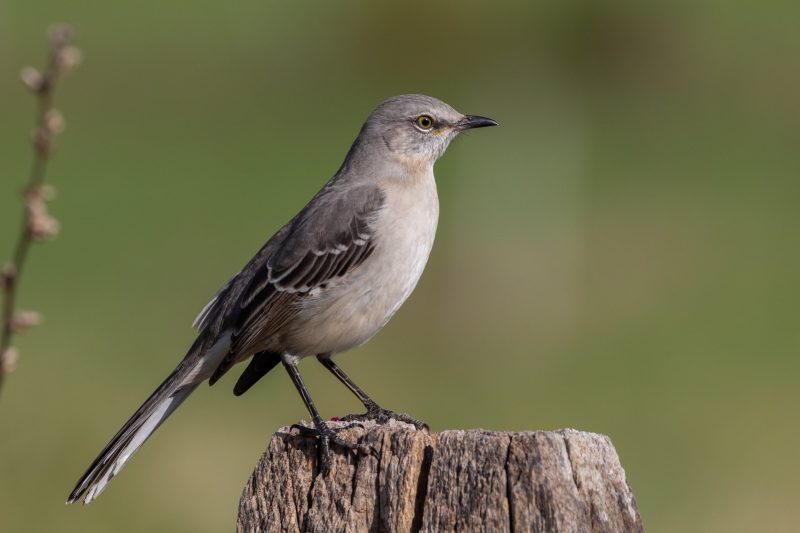
The Northern Mockingbird is a slender, gray bird with a long tail, white wing patches, and bright yellow eyes. Measuring 8 to 10 inches in length with a wingspan of 12 to 15 inches, it is easily recognized when it flashes its wings in flight or while foraging on the ground. Its most famous trait, however, is its unmatched singing ability.
Mockingbirds are common across New York, especially in suburban areas, open fields, and city parks. They are vocal year-round, with males capable of singing hundreds of different song variations, often mimicking other birds, animals, and even man-made sounds. These birds are also known for their boldness, fiercely defending their nests against much larger animals, including hawks and cats.
A fun fact about Northern Mockingbirds is that they continue learning new sounds throughout their lives. A single bird may have a repertoire of over 200 songs. Their remarkable mimicry and fearless behavior make them both entertaining and impressive residents of New York’s bird community.
Eastern Bluebird (Sialia sialis)
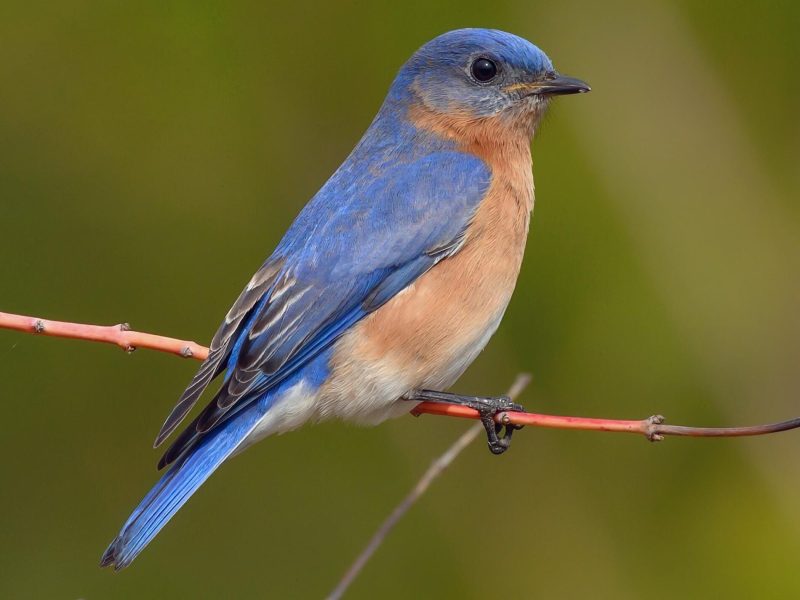
The Eastern Bluebird is a symbol of happiness and renewal, easily recognized by the male’s bright blue plumage and warm reddish-brown chest. Females are more subdued in color, with grayish-blue wings and paler orange underparts. These small thrushes measure about 6.5 to 8 inches in length with a wingspan of 9 to 12 inches, making them slightly smaller than robins but equally graceful.
In New York, Eastern Bluebirds are often seen in open fields, meadows, orchards, and along rural roadsides. They nest in cavities, often using nest boxes provided by people, which has helped their population recover after past declines. Their diet consists mainly of insects in summer and berries in winter, making them seasonal helpers in controlling pest populations.
A fun fact about Eastern Bluebirds is that they can be spotted perching quietly on fence posts or wires, scanning the ground for insects before swooping down to catch them. Their gentle, flute-like song adds a sweet sound to the countryside, and many birdwatchers consider the return of bluebirds each spring a highlight of the season in New York.
Cedar Waxwing (Bombycilla cedrorum)
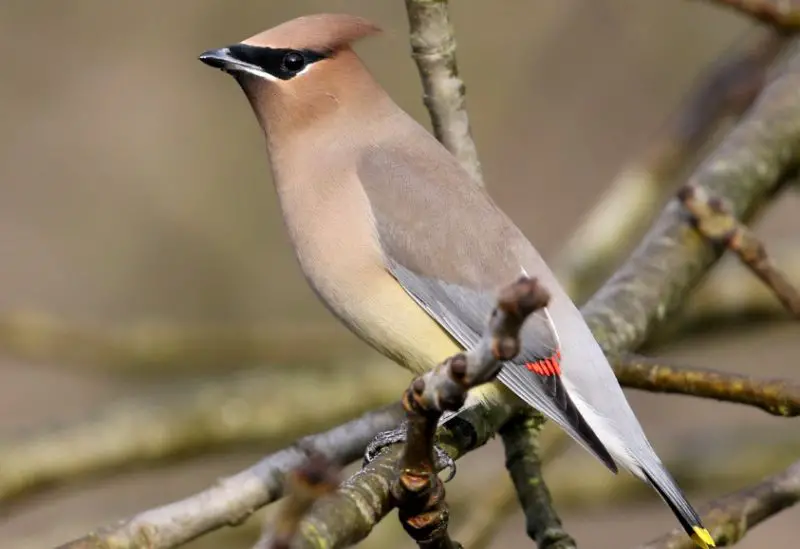
The Cedar Waxwing is one of the most elegant birds in New York, known for its sleek appearance and silky plumage. It has a soft brown head and chest, pale yellow belly, black mask, and a crest that gives it a regal look. Its wings are gray with distinctive red wax-like tips, and its tail ends in a bright yellow band. Measuring 6 to 7 inches long with a wingspan of 8 to 11 inches, it is a medium-sized songbird with striking beauty.
Cedar Waxwings are highly social and often travel in flocks, especially during summer and fall. They are fruit specialists, feeding heavily on berries such as cedar, serviceberry, and mulberry, though they also eat insects during the breeding season. These birds are commonly found in orchards, woodlands, parks, and suburban neighborhoods across New York, especially where fruiting trees and shrubs are abundant.
A fun fact about Cedar Waxwings is that they sometimes pass berries to each other along a perch before one bird finally eats it. This social behavior, combined with their soft, high-pitched calls, makes them delightful to observe. Their polished appearance and unique diet make them one of the most elegant and admired birds in the state.
American Tree Sparrow (Spizelloides arborea)
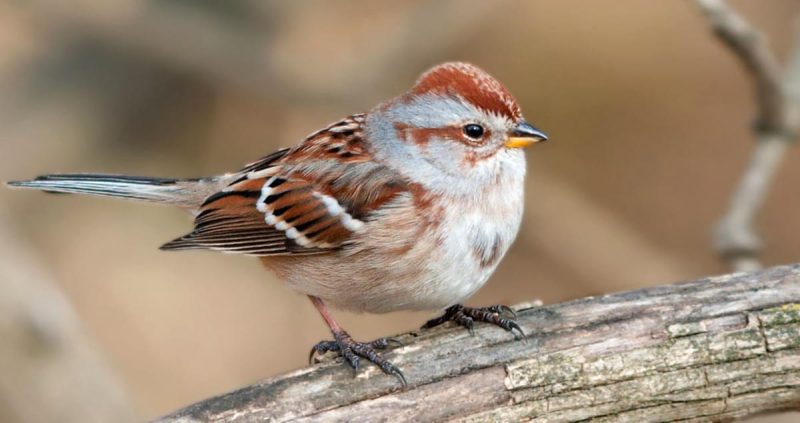
The American Tree Sparrow is a winter visitor in New York, easily recognized by its rusty cap and a dark central spot on its chest. These sparrows breed in the Arctic tundra but migrate southward during the colder months, making them a familiar sight at feeders. Their gentle appearance and soft calls make them a welcome addition to winter birdwatching.
This species favors open fields, shrubby areas, and backyard feeders where millet and sunflower seeds are offered. Their flocks often forage on the ground, moving quickly through snowy landscapes in search of food. They play an important role in controlling weed seeds during the colder season.
In New York, the American Tree Sparrow is present mainly from late fall through early spring before returning north to breed. Their calm demeanor and seasonal presence highlight the changes in bird communities throughout the year.
Chipping Sparrow (Spizella passerina)
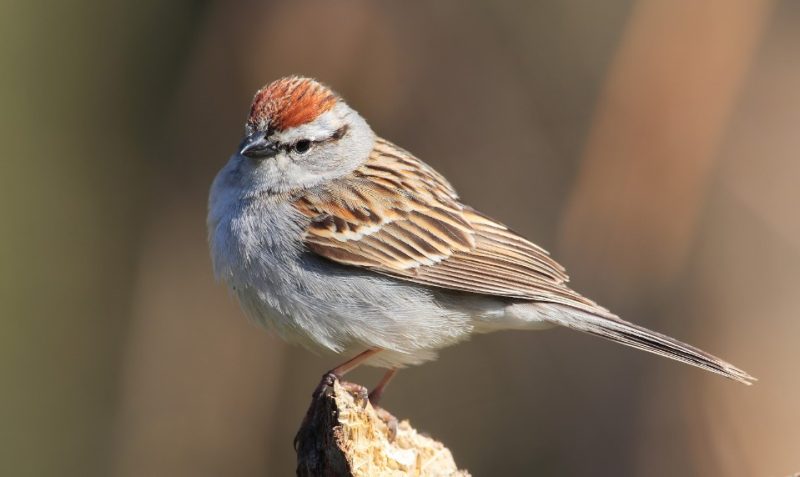
The Chipping Sparrow is a small, slender bird recognized by its bright rufous cap, black eye line, and clean gray underparts. During the breeding season, they are among the most common sparrows in suburban yards, parks, and woodland edges. Their trilling song is a hallmark of spring and summer in New York.
These sparrows prefer open woodlands and grassy areas with scattered trees. They often forage on the ground for seeds and insects, making them useful in reducing garden pests. They readily adapt to human presence and are frequently seen at feeders.
In New York, the Chipping Sparrow is a summer resident, migrating south in winter. Their presence signals the arrival of warmer weather, and they often nest in shrubs or low branches near homes and gardens.
Dark-eyed Junco (Junco hyemalis)
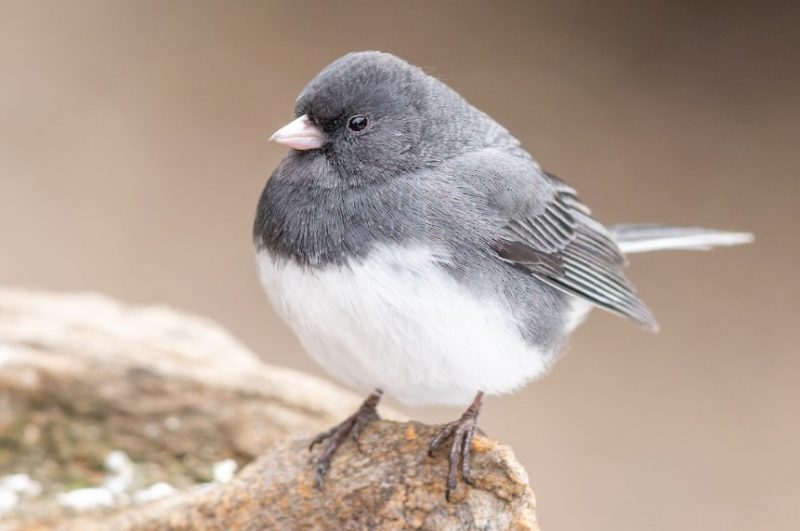
The Dark-eyed Junco, often called the “snowbird,” is a familiar winter visitor in New York. With their slate-gray plumage, white bellies, and flashing white outer tail feathers, they are easily recognized as they hop along the ground. These birds often travel in flocks, creating a lively presence at feeders.
They thrive in woodland edges, parks, and suburban backyards during the colder months. Their diet consists mainly of seeds, but they will also consume insects when available. Their ground-foraging habits make them a common sight beneath feeders where spilled seeds accumulate.
Dark-eyed Juncos breed in Canada and the northern United States but migrate southward to New York in winter. Their seasonal arrival is often associated with the first snowfalls of the year.
Red-bellied Woodpecker (Melanerpes carolinus)
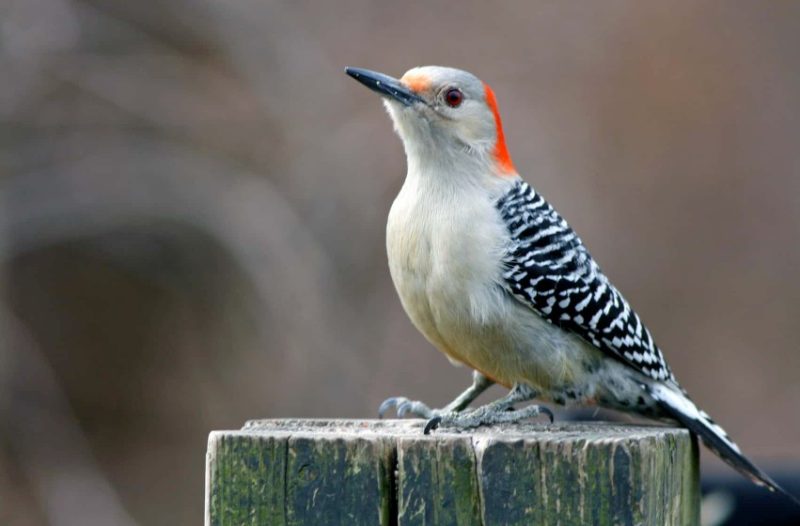
The Red-bellied Woodpecker is a striking bird with black-and-white barred wings and a red patch that extends from its nape to crown in males. Despite its name, the reddish wash on its belly is faint and often difficult to see. It is a year-round resident in New York.
This species is commonly found in forests, wooded suburbs, and parks. It feeds on insects, nuts, seeds, and fruits, often storing food in tree crevices for later use. Its rolling call and drumming sounds are distinctive markers of its presence.
In New York, Red-bellied Woodpeckers have expanded their range northward over the past decades. They adapt well to backyard feeders, especially those offering suet and sunflower seeds.
Downy Woodpecker (Dryobates pubescens)
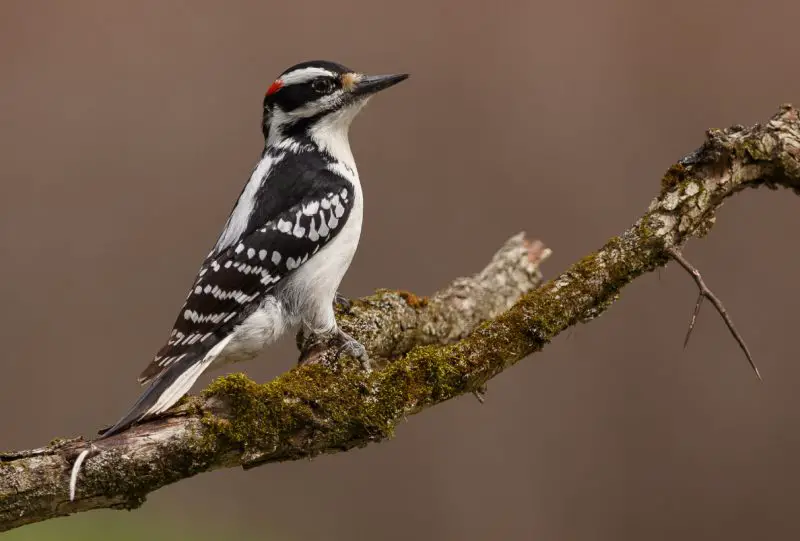
The Downy Woodpecker is the smallest woodpecker in New York, identifiable by its black-and-white plumage and small bill. Males have a small red patch on the back of the head. They are often seen clinging to tree trunks or visiting suet feeders.
They inhabit woodlands, orchards, parks, and suburban areas. Their diet consists of insects, larvae, and seeds, making them beneficial for controlling tree pests. Their drumming is softer compared to larger woodpeckers.
This species is a year-round resident in New York, frequently found in both rural and urban areas. Their adaptability and approachable nature make them one of the most commonly observed backyard woodpeckers.
Hairy Woodpecker (Dryobates villosus)
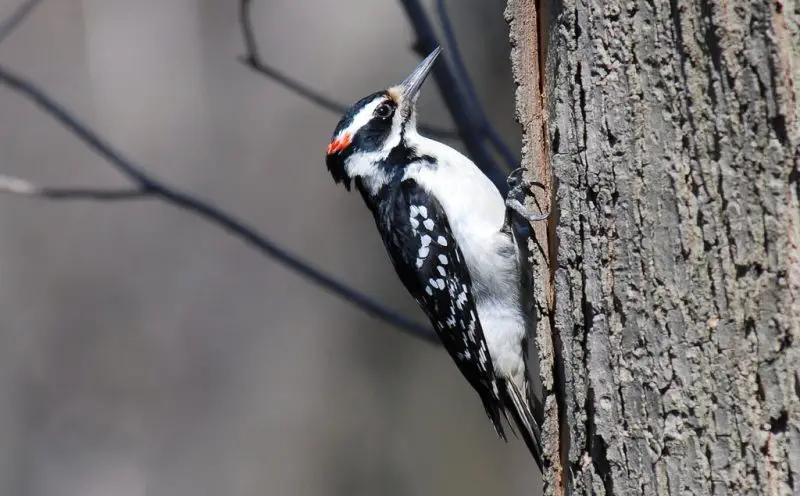
The Hairy Woodpecker looks very similar to the Downy Woodpecker but is larger with a noticeably longer bill. They share the same striking black-and-white pattern, with males showing a red patch on the back of the head. Distinguishing between the two species can be challenging for beginners.
Hairy Woodpeckers prefer mature forests but also visit suburban backyards with suet feeders. They are strong foragers, chiseling into bark to find hidden insects and larvae. Their drumming is louder and more powerful than that of the Downy.
In New York, they are permanent residents, found in woodlands, parks, and neighborhoods with mature trees. Their resilience and adaptability allow them to thrive throughout the year.
Northern Flicker (Colaptes auratus)
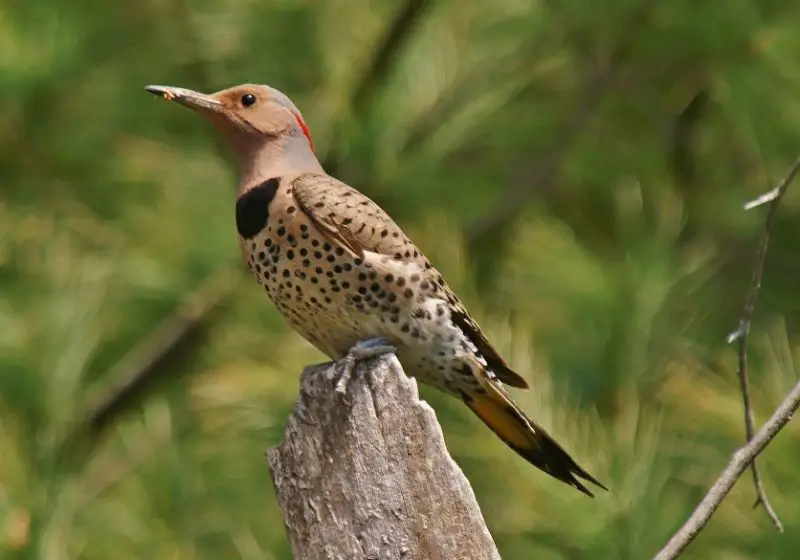
The Northern Flicker is a large woodpecker with a distinctive brownish body covered in black spots, a white rump, and a barred back. Males feature a black mustache-like mark on their face, while both sexes have bright yellow or red shafts on their flight feathers, depending on the region. Measuring 11 to 12 inches in length with a wingspan of 16 to 20 inches, their size and colorful markings make them easy to spot in New York.
These birds are commonly found in open woodlands, forest edges, and suburban parks. Unlike many woodpeckers, Northern Flickers often forage on the ground, feeding primarily on ants and beetles. They also consume fruits and seeds, making them versatile in their dietary habits. Their loud, rolling “flicker” calls and rapid drumming on trees or posts make their presence unmistakable.
A fun fact about Northern Flickers is that they sometimes nest in abandoned woodpecker holes and can excavate cavities in soft or decaying wood. Their combination of striking plumage, distinctive calls, and ground-feeding behavior makes them a favorite among birdwatchers in New York.
Pileated Woodpecker (Dryocopus pileatus)
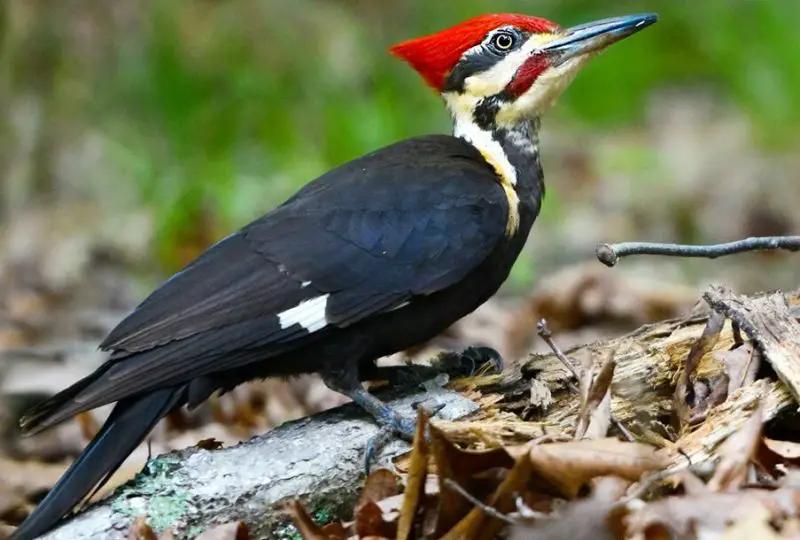
The Pileated Woodpecker is one of the largest woodpeckers in North America, measuring 16 to 19 inches in length with a wingspan of 26 to 30 inches. Its striking black body, white stripes along the face and neck, and bright red crest make it unmistakable in New York forests. The bird’s long, chisel-like bill allows it to excavate large holes in trees to find carpenter ants and other insects.
Pileated Woodpeckers prefer mature forests with large trees, but they are also seen in wooded suburban areas. They are known for their powerful drumming and loud, ringing calls that can carry for miles. These birds create nesting cavities that are later used by other species, making them important ecosystem engineers.
A fun fact about Pileated Woodpeckers is that their excavated holes can be so large that they resemble small woodpecker “windows” on tree trunks. Observing one hammering a tree in New York’s forests is a memorable experience for any birder.
Tufted Titmouse (Baeolophus bicolor)
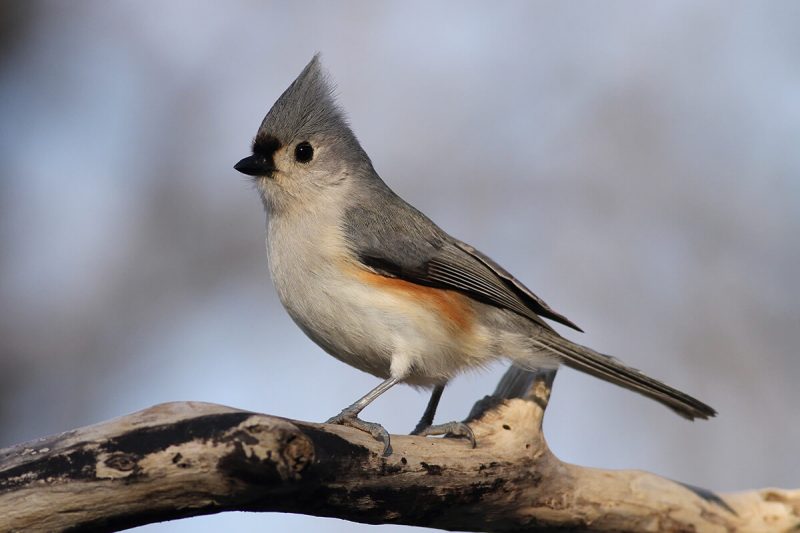
The Tufted Titmouse is a small, gray bird with a prominent crest on its head, a white face, and a black forehead patch. Measuring 5.5 to 6 inches in length with a wingspan of 7 to 10 inches, it has a compact and rounded body, often seen flitting energetically among branches. Its soft whistled calls and lively movements make it easy to recognize in New York woodlands and backyards.
These birds inhabit deciduous and mixed forests, suburban gardens, and parks, often visiting feeders with sunflower seeds, suet, or peanuts. They forage actively, searching for insects, seeds, and berries, and sometimes store food for later use. Tufted Titmice are social birds, often forming small flocks with chickadees and nuthatches during winter.
A fun fact about Tufted Titmice is that they are known to be curious and bold, frequently inspecting new objects in their environment. Their energetic behavior and friendly nature make them a favorite among backyard birdwatchers in New York.
White-breasted Nuthatch (Sitta carolinensis)
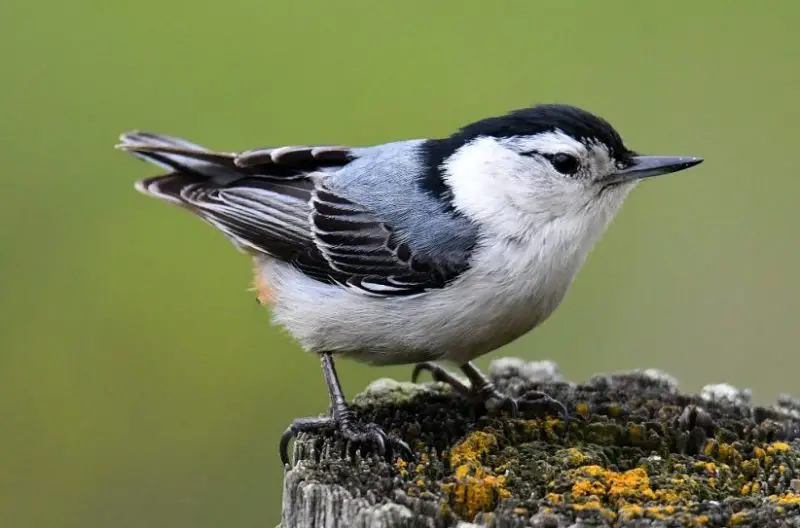
The White-breasted Nuthatch is a small, stocky bird with a white face and underparts, blue-gray back, and a black cap in males or dark gray in females. Measuring 5 to 6 inches in length with a wingspan of 8 to 10 inches, it is often seen creeping headfirst down tree trunks, an unusual behavior among birds that helps it find hidden insects.
They prefer mature forests, woodland edges, and suburban areas with large trees. Their diet consists of insects, seeds, and nuts, which they often wedge into bark crevices to hammer open with their strong bills. White-breasted Nuthatches are also regular visitors to backyard feeders, particularly those offering sunflower seeds.
A fun fact about White-breasted Nuthatches is their ability to move headfirst down tree trunks, giving them a unique vantage point to locate prey. This acrobatic behavior, combined with their nasal calls, makes them a distinctive presence in New York’s forests and parks.
Red-breasted Nuthatch (Sitta canadensis)
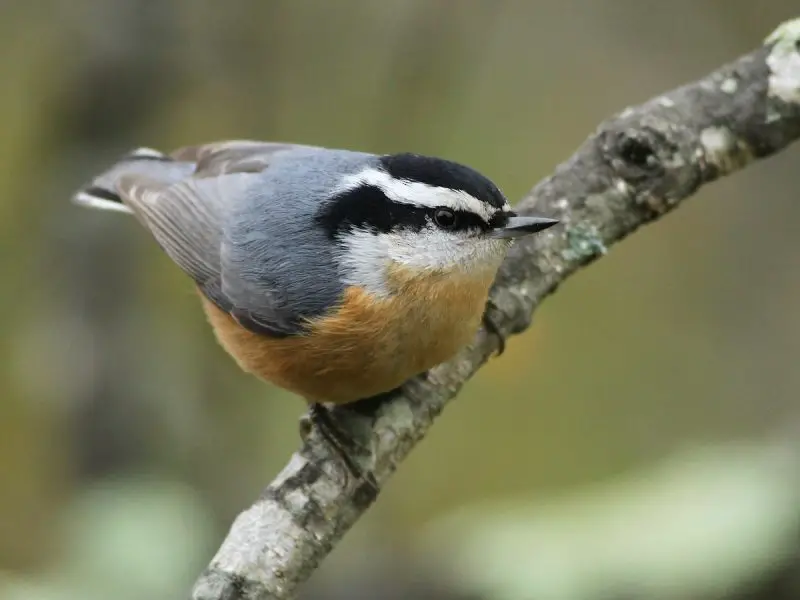
The Red-breasted Nuthatch is a small, compact bird with a bluish-gray back, rusty underparts, a black stripe through the eye, and a white supercilium above it. Measuring 4.5 inches in length with a wingspan of 7.5 to 8.5 inches, it is slightly smaller than the White-breasted Nuthatch but shares the unique habit of creeping headfirst down tree trunks.
In New York, Red-breasted Nuthatches are most common in coniferous forests, especially spruce and pine stands. They feed on insects, seeds, and occasionally sap, often storing food in bark crevices. These birds are highly vocal, producing nasal “yank-yank” calls that are easily recognized.
A fun fact about Red-breasted Nuthatches is that they often move in mixed-species flocks with chickadees and kinglets during winter, increasing their chances of finding food. Their small size, rapid movements, and energetic calls make them a delightful species to observe in New York’s evergreen forests.
Baltimore Oriole (Icterus galbula)
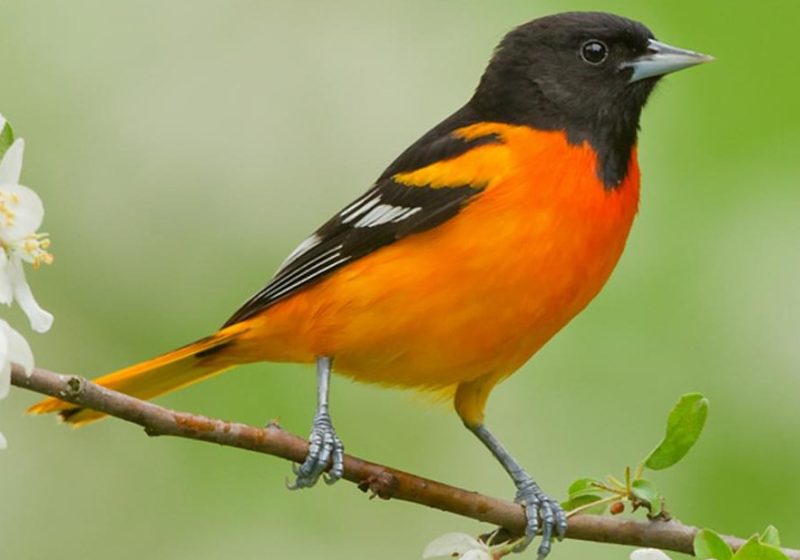
The Baltimore Oriole is a medium-sized, striking bird, with males displaying bright orange underparts and black heads, wings, and backs. Females are more subdued, with yellow-orange underparts and grayish-brown backs. Measuring 6.5 to 7.5 inches in length with a wingspan of 9 to 12 inches, these orioles are easily spotted in flowering trees and backyard feeders during the breeding season.
In New York, Baltimore Orioles prefer open woodlands, edges, and suburban areas with tall deciduous trees. They feed on nectar, fruits, and insects, often visiting hanging fruit and nectar feeders. Their intricate, hanging pouch nests, woven from fibers and grasses, are a marvel of avian engineering.
A fun fact about Baltimore Orioles is that their woven nests can be up to 12 inches long and are suspended from slender branches, making them difficult for predators to reach. Their bright colors, cheerful songs, and elaborate nests make them one of the most admired birds by New York birdwatchers.
Scarlet Tanager (Piranga olivacea)
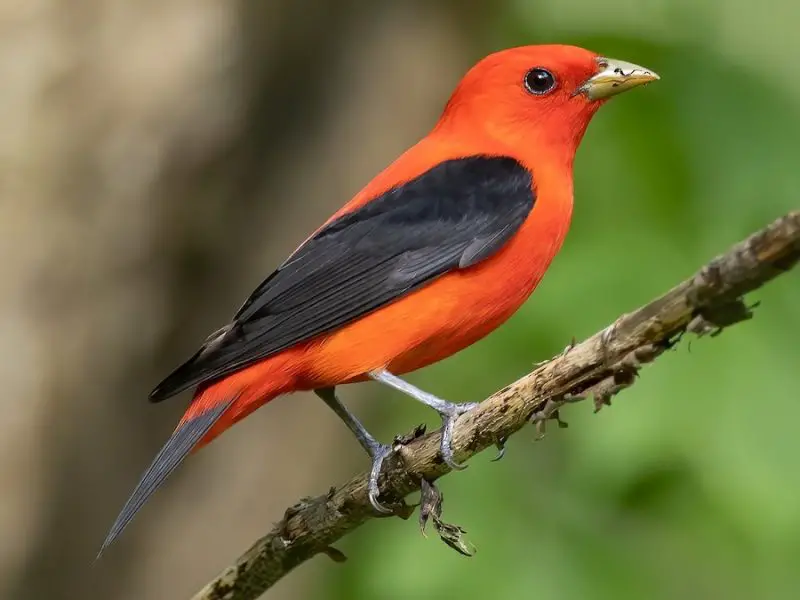
The Scarlet Tanager is a striking songbird, with males displaying brilliant red bodies contrasted by jet-black wings and tail during the breeding season. Females are olive-yellow all over, making them more cryptic. Measuring 6.3 to 7.5 inches in length with a wingspan of 10 to 12 inches, they are medium-sized but stand out vividly in the leafy canopy of New York forests.
Scarlet Tanagers breed in deciduous and mixed forests, often high in the treetops where they feed on insects and fruit. They are shy and can be difficult to spot despite their bright coloration. During migration, they may pass through open woodlands, parks, and gardens, providing birdwatchers with fleeting glimpses.
A fun fact about Scarlet Tanagers is that their vivid red color comes from pigments in their diet, particularly carotenoids from insects and berries. In autumn, males molt into a more subdued olive color similar to females, helping them stay less conspicuous during migration.
Indigo Bunting (Passerina cyanea)
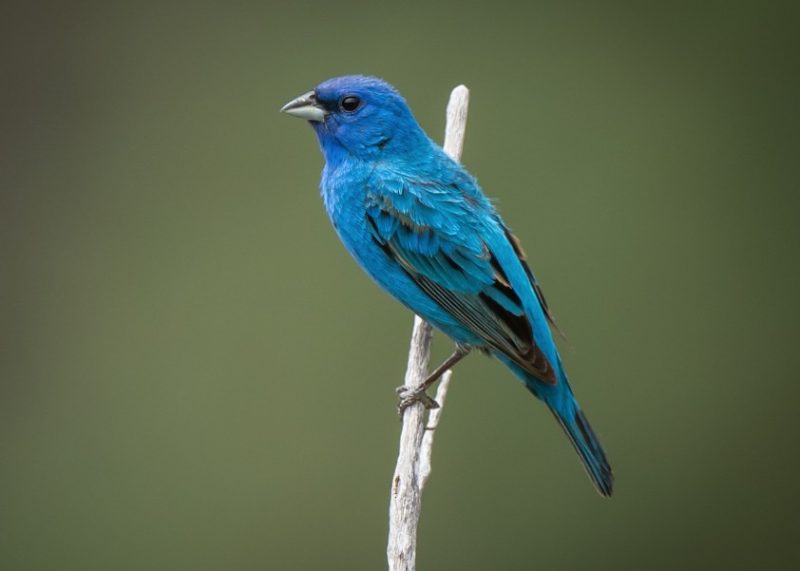
The Indigo Bunting is a small, vibrant bird with adult males displaying striking blue plumage throughout the breeding season, while females are a more subdued brown. They measure about 4.5 to 5 inches in length with a wingspan of 7 to 9 inches. Their bright blue feathers make males highly visible in New York’s brushy fields, woodland edges, and gardens.
These buntings feed primarily on seeds, berries, and insects. They often perch atop shrubs and small trees, singing a sweet, high-pitched warble to establish territory and attract mates. During migration, Indigo Buntings travel at night, navigating using the stars.
A fun fact about Indigo Buntings is that the males’ blue coloration is not from pigment but from the structure of their feathers, which scatters light to produce the vivid blue hue. Their brilliant color and melodious song make them a favorite target for birdwatchers in New York.
Eastern Towhee (Pipilo erythrophthalmus)
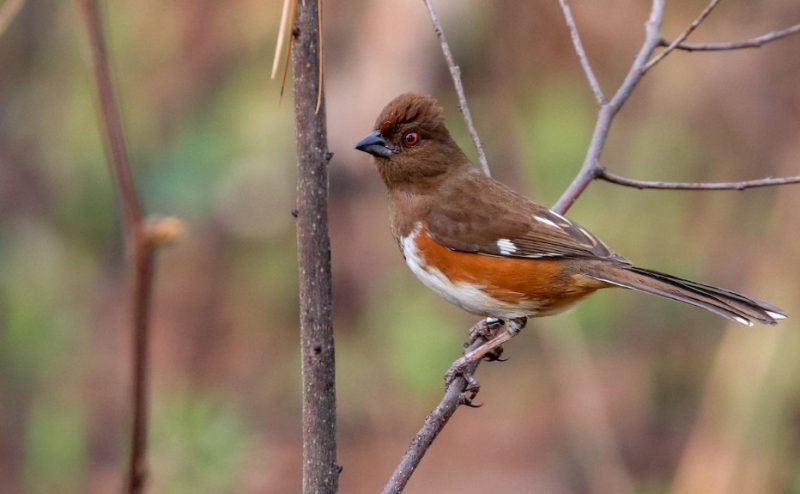
The Eastern Towhee is a large sparrow with bold black-and-rust coloration in males, with white underparts and reddish-brown flanks, while females are more muted in browns. Measuring 7 to 8 inches long with a wingspan of 10 to 12 inches, they are relatively large for sparrows. They are often identified by their sharp “drink-your-tea” song, a classic call in New York’s woodland edges and brushy areas.
Towhees forage mostly on the ground, scratching through leaf litter for seeds, insects, and berries. They prefer thick underbrush, shrubby areas, and forest edges, where they can stay hidden while foraging. Their strong legs and tail movements help them stir up food efficiently.
A fun fact about Eastern Towhees is that their distinctive foraging method, known as “double-scratching,” involves hopping backward while kicking leaves to uncover hidden prey. Observing this behavior in New York’s forests or gardens is a delightful experience for bird enthusiasts.
Yellow Warbler (Setophaga petechia)
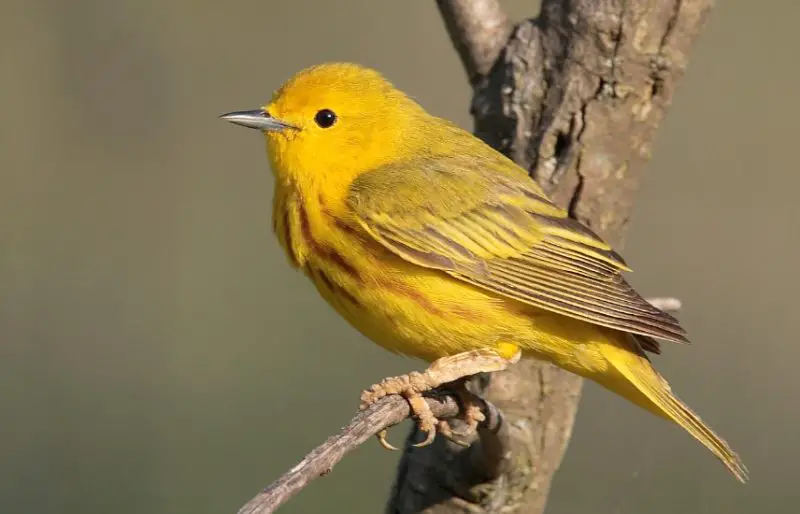
The Yellow Warbler is a small, bright bird with vivid yellow plumage and subtle reddish streaks on the chest in males, while females are slightly duller. Measuring 4.5 to 5 inches in length with a wingspan of 6.7 to 7.9 inches, their cheerful color and song make them easily noticeable in New York’s thickets, wetlands, and orchards.
These warblers primarily feed on insects and caterpillars, often gleaning prey from leaves and branches. They are active foragers, flitting through foliage with agility and speed. Yellow Warblers are also known for their sweet, musical “sweet-sweet-sweet, I’m so sweet” song, which resonates through summer landscapes.
A fun fact about Yellow Warblers is that females often lay eggs near the nests of predatory birds, such as cuckoos, to reduce predation risk, a clever strategy to improve survival rates. Their bright plumage and lively behavior make them a favorite among New York birdwatchers.
Black-and-white Warbler (Mniotilta varia)
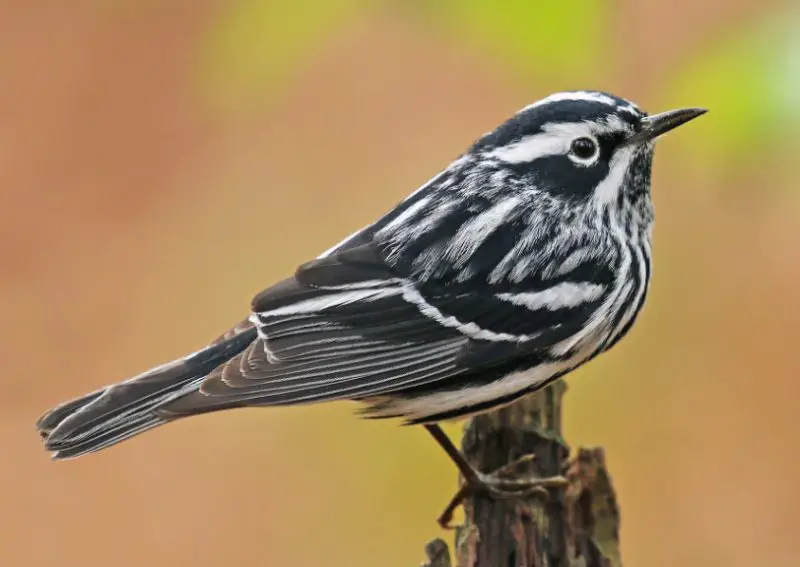
The Black-and-white Warbler is a small songbird with striking black-and-white streaked plumage, making it resemble a tiny woodpecker. Measuring 4.3 to 5 inches in length with a wingspan of 7 to 8 inches, it is known for creeping along tree trunks and branches in search of insects. This behavior is unusual among warblers and makes them stand out in New York forests.
These warblers inhabit deciduous and mixed woodlands, particularly favoring trees with rough bark where insects hide. Their diet consists mainly of caterpillars, beetles, and other small invertebrates. During migration, they also pass through suburban parks and wooded gardens.
A fun fact about Black-and-white Warblers is that their foraging technique closely resembles that of nuthatches, moving headfirst down tree trunks. This unique habit helps them exploit a niche less used by other warblers and makes them an interesting species to observe in New York.
Common Yellowthroat (Geothlypis trichas)

The Common Yellowthroat is a small, energetic warbler with bright yellow underparts and olive-brown upperparts. Males have a distinctive black mask across the eyes, while females lack the mask and are slightly duller. They measure 4 to 5 inches long with a wingspan of 5.5 to 7 inches and are often heard before they are seen in New York’s marshes, wetlands, and brushy areas.
These warblers feed on insects, spiders, and other small invertebrates, often gleaning them from dense vegetation near water. Their “wichity-wichity-wichity” song is a hallmark of wetland and shrubby habitats during the breeding season. They are often elusive, staying hidden in thick cover while foraging.
A fun fact about Common Yellowthroats is that their black mask may help reduce glare from the sun while they forage in bright, open areas, giving them better focus on prey. Their bold songs and bright yellow coloring make them a charming and lively species to encounter in New York.
American Redstart (Setophaga ruticilla)
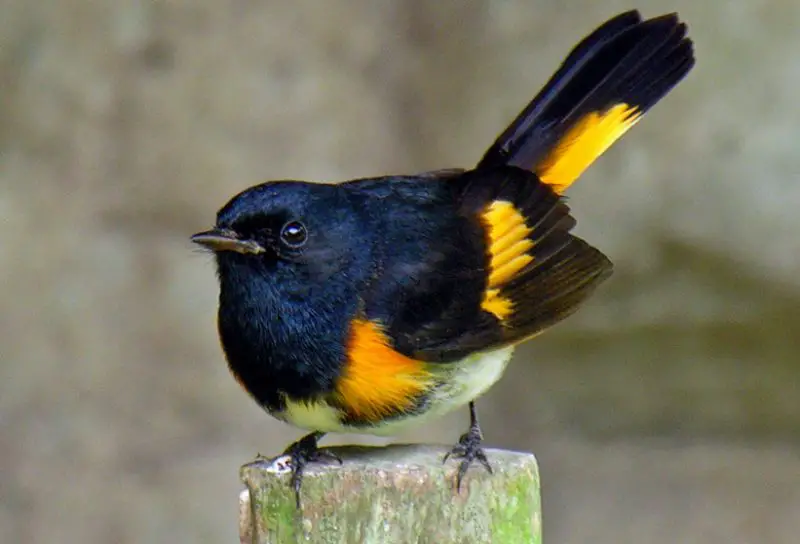
The American Redstart is a small, striking warbler known for its contrasting black and orange plumage in males, while females display yellow and gray tones. Measuring 4.3 to 5 inches in length with a wingspan of 6.7 to 7.5 inches, its vivid colors and energetic behavior make it easily noticeable in New York’s forests and gardens.
These warblers prefer deciduous woodlands, forest edges, and shrubby areas. They are highly active foragers, constantly fanning their tails and wings to startle insects from foliage, which they then capture mid-air or glean from leaves. Their insectivorous diet makes them valuable for controlling pest populations.
A fun fact about American Redstarts is that males are known to vigorously flash their bright tail and wing patches while foraging, a behavior thought to confuse insects and aid in hunting. Their lively movements and striking plumage make them a favorite among New York birdwatchers during migration and breeding seasons.
Ovenbird (Seiurus aurocapilla)
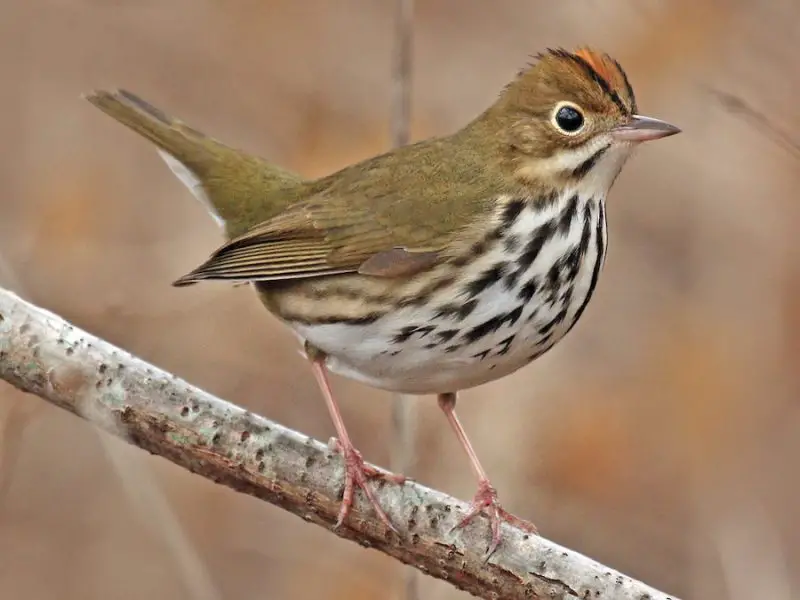
The Ovenbird is a medium-sized warbler with olive-brown upperparts, streaked white underparts, and an unmistakable orange crown bordered with black. Measuring 5 to 6 inches in length with a wingspan of 8.7 to 10 inches, it is easily identified by its unique ground-dwelling habits and distinctive “teacher-teacher-teacher” song.
Ovenbirds prefer mature deciduous and mixed forests, nesting on the forest floor inside domed nests that resemble old-fashioned ovens, which gives the species its name. They forage among leaf litter, feeding on insects, spiders, and small invertebrates. In New York, they are often heard singing in spring rather than seen, as they remain well hidden.
A fun fact about Ovenbirds is that their ground-level nesting makes them vulnerable to predators, yet their camouflaged plumage and nest structure offer excellent protection. Observing their song echoing through New York forests is a sure sign of spring.
Barn Swallow (Hirundo rustica)

The Barn Swallow is a slender, agile bird with a deeply forked tail, metallic blue back, and reddish-orange throat and forehead. Measuring 5.5 to 7 inches in length with a wingspan of 11 to 13 inches, they are easily recognized in flight over fields, ponds, and suburban areas throughout New York.
These swallows are aerial insectivores, capturing flying insects on the wing with remarkable agility. They often build mud cup nests under eaves, bridges, or barns, and are highly social, forming large colonies during the breeding season. Their acrobatic flight and cheerful chirps make them a familiar and delightful sight.
A fun fact about Barn Swallows is that their forked tails and streamlined bodies make them incredibly efficient fliers, capable of catching insects mid-air with pinpoint accuracy. They are long-distance migrants, wintering in Central and South America before returning to New York each spring.
Tree Swallow (Tachycineta bicolor)
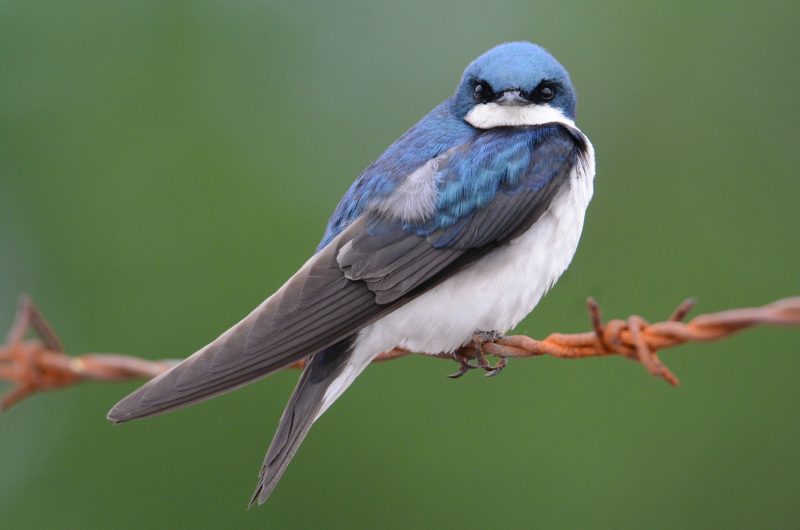
The Tree Swallow is a small, graceful bird with metallic blue-green upperparts and white underparts. Measuring 5 to 6 inches in length with a wingspan of 11 to 13 inches, it is a frequent sight in New York, especially around wetlands, ponds, and nest boxes provided by humans.
Tree Swallows are highly skilled aerial insectivores, often seen gliding and swooping in groups while catching insects mid-air. They nest in tree cavities or nest boxes and are known to compete with other cavity-nesting species like bluebirds. Their diet also includes small berries during late summer and early fall.
A fun fact about Tree Swallows is that they are highly social and can gather in flocks of hundreds or even thousands during migration. Their shimmering blue feathers and agile flight patterns make them a beautiful and fascinating species to watch in New York skies.
Chimney Swift (Chaetura pelagica)
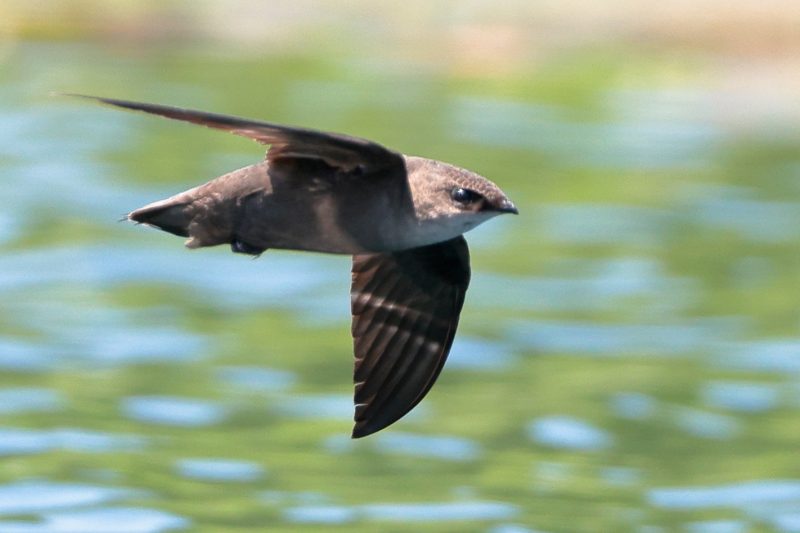
The Chimney Swift is a small, cigar-shaped bird with sooty brown plumage, long wings, and a short, stubby tail. Measuring 5 to 6 inches in length with a wingspan of 11 to 12 inches, they are nearly always observed in flight, darting and twisting in search of flying insects.
In New York, Chimney Swifts have adapted to nesting in chimneys, hollow trees, and occasionally in large buildings. Their diet consists entirely of aerial insects, making them highly agile and acrobatic fliers. They often gather in large communal roosts, especially during migration.
A fun fact about Chimney Swifts is that they can spend the majority of their lives airborne, even drinking and sleeping on the wing. Their unique flight style and communal roosting behavior make them one of New York’s most fascinating aerial specialists.
Ruby-throated Hummingbird (Archilochus colubris)
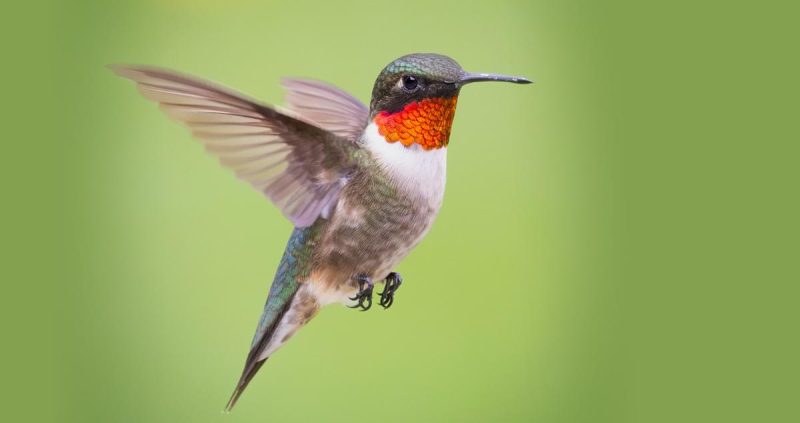
The Ruby-throated Hummingbird is a tiny, iridescent bird, with males displaying a brilliant red throat, green back, and white underparts. Females lack the red throat and have a more muted greenish back. Measuring only 3 to 3.5 inches long with a wingspan of 3.1 to 4.3 inches, they are among the smallest birds in New York.
These hummingbirds are highly territorial and feed primarily on nectar from flowers, as well as small insects and spiders for protein. They are frequently seen hovering in gardens, woodlands, and around feeders, capable of rapid wingbeats and agile maneuvers that allow them to access nectar with precision.
A fun fact about Ruby-throated Hummingbirds is that they are the only hummingbird species that regularly breeds in eastern North America and can migrate nonstop across the Gulf of Mexico. Their dazzling iridescent colors and remarkable flying abilities make them a highlight of New York’s summer birdwatching season.
Great Blue Heron (Ardea herodias)
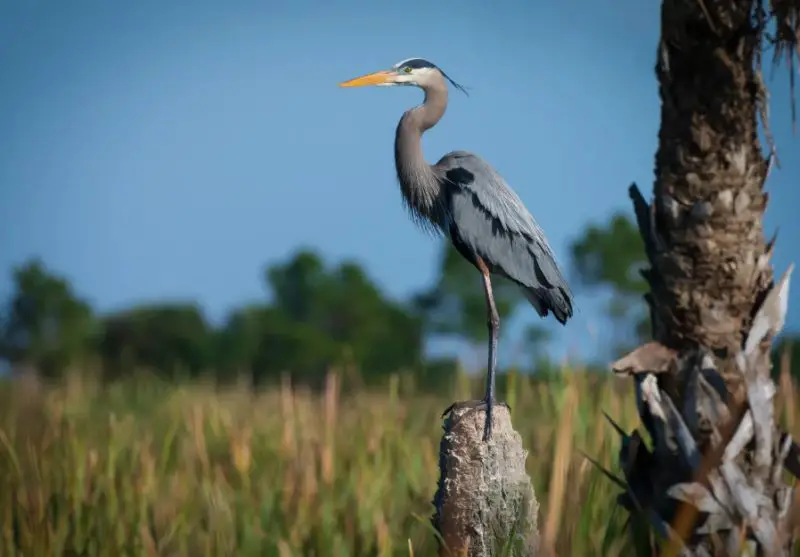
The Great Blue Heron is a large, elegant wading bird with slate-blue plumage, a long neck, and a sharp yellow bill. Adults stand about 3.2 to 4.5 feet tall with a wingspan of 5.5 to 6.6 feet, making them one of the largest birds in New York’s wetlands. They have a slow, deliberate flight with neck folded into an “S” shape and long legs trailing behind, easily identifiable from a distance.
These herons inhabit freshwater and saltwater marshes, rivers, lakes, and shorelines. They are solitary hunters, standing motionless or slowly stalking prey, feeding on fish, amphibians, small mammals, and occasionally insects. Great Blue Herons are also known for nesting in colonies called heronries, often in tall trees near water.
A fun fact about Great Blue Herons is that their hunting technique includes a lightning-fast spear with their bill to capture prey. Observing them patiently stalking fish in New York wetlands is a classic and serene wildlife experience.
Canada Goose (Branta canadensis)
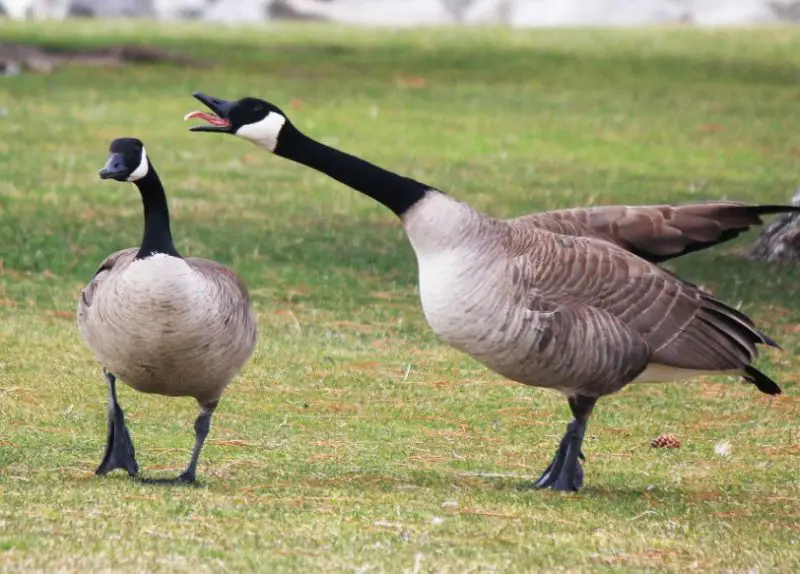
The Canada Goose is a large waterfowl species with a distinctive black head and neck, white chinstrap, and brownish body. Adults measure 30 to 43 inches in length with a wingspan of 50 to 73 inches. They are highly recognizable in New York, often seen in flocks flying in characteristic V-formations during migration.
Canada Geese are highly adaptable and can be found in ponds, lakes, rivers, urban parks, and agricultural fields. They are primarily herbivorous, feeding on grasses, grains, and aquatic vegetation, but may also graze in lawns and golf courses. They are social birds, often forming family groups outside of the breeding season.
A fun fact about Canada Geese is that they mate for life and are fiercely protective of their nests. Their migratory flocks and honking calls are iconic sights and sounds across New York, especially during spring and fall migrations.
Mallard (Anas platyrhynchos)
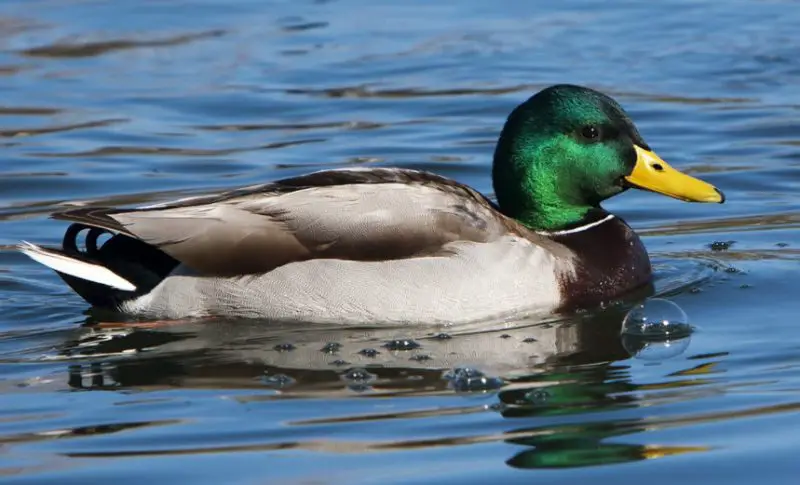
The Mallard is a common dabbling duck easily recognized by the male’s glossy green head, yellow bill, chestnut-brown chest, and gray body. Females are mottled brown with orange bills. They measure 20 to 26 inches in length with a wingspan of 32 to 39 inches, making them medium-sized but highly visible in New York waters.
Mallards are highly adaptable, frequenting ponds, rivers, lakes, wetlands, and even urban parks. They feed on aquatic plants, seeds, insects, and small fish, often tipping forward to dabble or upend in shallow water. Their loud quacks, especially from females, make them unmistakable in any habitat.
A fun fact about Mallards is that they are the ancestors of most domestic duck breeds. In New York, they are year-round residents in many areas, with migration adding large flocks in the spring and fall, making them one of the most familiar and widely observed waterfowl species.
FAQs about Birds in New York
What are the most common backyard birds in New York?
New York backyards commonly host species such as American Robins, Northern Cardinals, Blue Jays, Black-capped Chickadees, Mourning Doves, and House Finches. These birds are attracted to feeders, shrubs, and gardens, providing easy viewing for birdwatchers.
When is the best time to see migratory birds in New York?
Spring (April to June) and fall (September to November) are the best times to observe migratory species. Birds like Ruby-throated Hummingbirds, American Redstarts, and Indigo Buntings pass through during these seasons, while others like Dark-eyed Juncos arrive in winter.
Where can I see waterfowl in New York?
Wetlands, lakes, ponds, and rivers are ideal locations. Species like Great Blue Herons, Mallards, and Canada Geese are commonly found in these habitats, especially in areas such as the Hudson River, Finger Lakes, and Adirondack wetlands.
What types of woodpeckers are found in New York?
New York hosts several woodpecker species including Downy, Hairy, Red-bellied, Pileated, and Northern Flicker. They can be spotted in forests, parks, and suburban areas, often identified by their drumming sounds and foraging behavior on tree trunks.
How can I attract birds to my backyard?
Providing bird feeders with seeds, suet, and nectar, planting native shrubs and trees, and supplying fresh water sources can attract a variety of birds. Creating sheltered areas also helps provide nesting and perching sites.
Are there endangered or rare birds in New York?
Yes, species such as the Cerulean Warbler and Kirtland’s Warbler are considered rare or of conservation concern. These species are typically found in specific habitats and require careful observation to avoid disturbing them.
Do birds in New York change plumage seasonally?
Many species undergo seasonal changes in plumage. For example, male Scarlet Tanagers and American Redstarts molt into less vivid colors after the breeding season, while some sparrows and warblers develop more muted tones during migration and winter.
Can I feed hummingbirds in New York?
Yes, providing sugar water in specialized hummingbird feeders attracts Ruby-throated Hummingbirds. Clean feeders regularly and avoid using red dye; the bright feeder itself is sufficient to attract them.
What are some fun behaviors to observe in New York birds?
Birds like the American Redstart flash their tails to startle insects, Eastern Towhees use double-scratching to forage, and Cedar Waxwings pass berries socially along a perch. Observing these behaviors can be both entertaining and educational.
Where can beginners go birdwatching in New York?
Popular beginner-friendly locations include Central Park, Jamaica Bay Wildlife Refuge, Hudson River parks, and the Adirondacks. These areas provide easy access, diverse habitats, and frequent sightings of common and migratory species.

